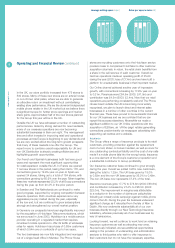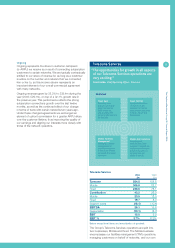Carphone Warehouse 2004 Annual Report Download - page 20
Download and view the complete annual report
Please find page 20 of the 2004 Carphone Warehouse annual report below. You can navigate through the pages in the report by either clicking on the pages listed below, or by using the keyword search tool below to find specific information within the annual report.
Corporate Governance
Introduction
The Board of Directors recognises the importance of high standards
of corporate governance. This Report and the Remuneration Report
set out on pages 20 to 23 explain how the Company complies with
the key corporate guidance set out in the Combined Code appended
to the Listing Rules.
Compliance with the Combined Code
During the period the Financial Reporting Council issued a new
Combined Code, which comes into effect for reporting years beginning
on or after 1 November 2003. Whilst the Board has considered the
principles and provisions of the new Combined Code, and will report
on compliance with it in next year’s Annual Report, the information
in this Report is given in relation to the version of the Combined Code
applicable for the period ended 27 March 2004.
Board
The Company has a well-balanced Board. There are five Executive
Directors and five Non-Executive Directors. Directors’ names and brief
biographies are set out on page 17. During the period, the appointment
of Martin Dawes as a Non-Executive Director became effective on
2 June 2003 and Des Wilson resigned as a Non-Executive Director
on 31 July 2003.
Hans Roger Snook is the Chairman, Charles Dunstone is Chief Executive
Officer and Sir Brian Pitman is the Senior Independent Director.
The Board considers that, other than Hans Roger Snook, each of
the Non-Executive Directors is independent of management and free
from any business or other relationship which could materially interfere
with the exercise of their independent judgement. The majority of
Non-Executive Directors are therefore independent.
Hans Roger Snook is not considered independent due to the fact that
he holds 1 million share options in the Company. Martin Dawes was
not considered independent during the period because as a previous
shareholder of Opal Telecom plc, which was acquired by the Group
in November 2002, he was entitled to receive part of any additional
consideration payable in respect of Opal’s performance in the two
financial periods ended 27 March 2004. The amount of such additional
consideration has now been calculated and as such the Board believes
that Martin Dawes is now independent in character and is free from any
relationship with the Company that could materially interfere with his
independent judgement.
The Board meets at least ten times a year, receiving key briefing
papers before each meeting. The Board is responsible to the
shareholders for the proper management of the Company and its
subsidiaries. It sets out and monitors the Group’s strategy, reviews its
trading performance, examines major capital expenditure, formulates
policy on key issues, ensures adequate funding and reports to
shareholders where appropriate.
The Board has underlined its commitment to internal control in the
Group by setting clear operating guidelines for all of its businesses, and
monitoring key performance indicators and risks on a monthly basis.
Board Committees
The Board has established three principal committees to consider
various aspects of the Group’s operations in more detail than would
be the case within full Board meetings. Details of the members of each
committee are given on page 17.
IAudit Committee
The Audit Committee comprises three independent Non-Executive
Directors and is chaired by Adrian Martin. The Committee meets at
least three times a year together with the Group’s internal audit and
risk management team and the Group’s external auditors. Terms of
reference for the Committee include reviewing the Annual Report
and interim statements, ensuring compliance with generally
accepted accounting principles and satisfying itself as to the
adequacy and effectiveness of the Group’s internal control
procedures. It receives reports from both internal and external
auditors on a regular basis.
II Remuneration Committee
The Remuneration Committee comprises three independent
Non-Executive Directors and is chaired by John Gildersleeve. The
Committee meets at least twice a year. Terms of reference include
making recommendations to the Board on the Group’s framework
of executive remuneration and determining on behalf of the Board
specific remuneration packages for the Executive Directors and
senior management. It also approves contractual terms and
incentives including bonus plans and executive share option
awards for Executive Directors and senior management. The
Remuneration Report is set out on pages 20 to 23.
III Nomination Committee
The Nomination Committee comprises two Non-Executive Directors
and David Ross and is chaired by Sir Brian Pitman. It advises
generally on Board appointments and the composition of the Board.
The Company’s policy is that each Non-Executive Director should
serve a maximum of two three year terms of office, unless there
are exceptional circumstances for their continued appointment.
Non-Executive Directors will continue to be subject to re-election every
three years and will be entitled to no compensation for loss of office.
Relations with shareholders
The Company maintains a regular dialogue with institutional
shareholders, primarily in the periods following announcements of
results. The importance of maintaining this dialogue is recognised
in order to ensure that the Group’s strategy is understood and that
concerns are addressed in a constructive way.
The Annual General Meeting will be used as a forum to communicate
with individual investors and is an opportunity to raise with the Directors
issues concerning the Group’s operations and performance. Investor
information including financial results, press releases and management
presentations are available at www.cpwplc.com.
Accountability and Audit
Internal control
The Board of Directors has overall responsibility for systems of internal
control throughout the Group and for reviewing their effectiveness. The
Board monitors all controls, including financial, operating and compliance
controls and risk management. The control systems in place are designed
to provide reasonable and not absolute assurance against misstatement
or loss and are designed to manage rather than eliminate the risk of
failure to achieve business objectives.
Among the principal features of the Group’s systems of internal control
is a planning process within which the Board approves strategy and
a Group business plan. Managers of individual business units prepare
plans and budgets covering a three year period. These plans
are challenged and approved by the Executive Board of Directors.
18
www.cpwplc.com
























